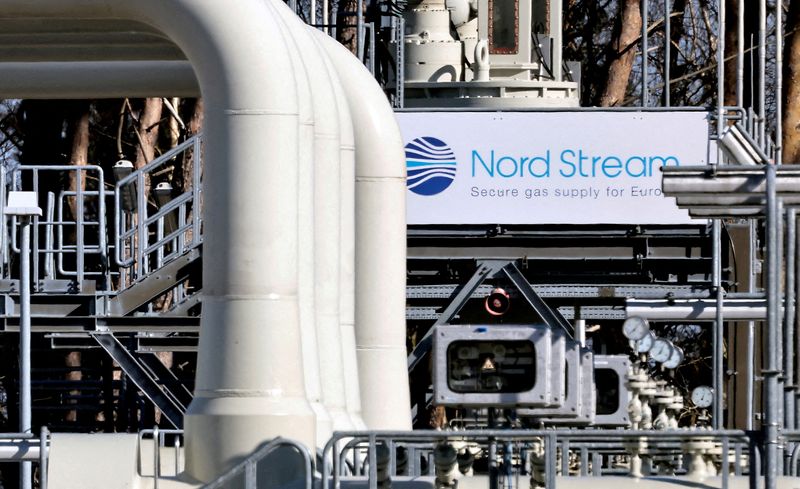By Christoph Steitz and Nina Chestney
FRANKFURT/LONDON -Russia resumed pumping gas via its biggest pipeline to Europe on Thursday after a 10-day outage, allaying some of Europe’s immediate supply fears but not enough to end the threat of rationing to cope with potential winter shortages.
Supplies via Nord Stream 1, which runs under the Baltic Sea to Germany, were halted for maintenance on July 11 but, even before that outage, flows had been cut to 40% of the pipeline’s capacity in a dispute sparked by Russia’s invasion of Ukraine.
Thursday’s flows were back at that 40% capacity level, Nord Stream figures showed, a day after Russian President Vladimir Putin warned that supplies could be cut further or even stop.
The resumption of Nord Stream supplies at levels that remain well below the pipeline’s capacity means Germany, which is particularly reliant on Russian fuel, and other European economies are still struggling to find enough gas for winter.
“In view of the missing 60% and the political instability, there is no reason yet to give the all-clear,” German network regulator president Klaus Mueller wrote on Twitter.
Gas flows via other pipeline routes, such as Ukraine, have also fallen since Russia invaded its neighbour in February, in what Moscow calls a “special military operation”.
Germany and several other states have already activated the first stages of emergency plans that in some cases could lead to rationing. Greece said on Thursday it would implement rotating power cuts as a last resort if necessary.
The EU aims to have gas storage facilities across the bloc 80% full by Nov. 1. Inventories are now about two-thirds full, with a slowing pace of refilling. https://tmsnrt.rs/3Ba2N2O
At current reduced flow rates, the German network regulator said Germany would struggle to reach its own target, which it said on Thursday it was raising to 95% by Nov. 1. Berlin said it would introduce other measures to save gas.
“Further disruptions are expected as Russia seeks to increase political and economic pressure on Europe as winter approaches,” Wood Mackenzie analyst Penny Leake said.
Gazprom, which has a monopoly on Russian gas exports by pipeline, did not respond to a request for comment.
EMERGENCY STEPS
To try to prevent a winter supply crunch, the European Commission has proposed a voluntary target for all EU states to cut gas use by 15% from August to March compared to usage in same period of 2016-2021. The Commission proposal would enable Brussels to make the target mandatory in a supply emergency.
“Russia is blackmailing us. Russia is using energy as a weapon,” EU Commission President Ursula von der Leyen said on Wednesday, adding that Europe had to prepare for the worst now.
Diplomats from at least 12 of the bloc’s 27 members raised concerns about the proposal at a meeting on Thursday, EU officials with knowledge of the meeting told Reuters. The proposal needs the backing of at least 15 EU countries.
The Kremlin, which says Russia is a reliable energy supplier, blamed sanctions for reduced flows and denied Von der Leyen’s accusations of blackmail. “This is an absolutely wrong statement,” spokesman Dmitry Peskov said on Thursday.
Kremlin-controlled Gazprom had cut gas exports via the Nord Stream route in June to 40% of capacity, blaming sanctions for delaying the return of a pipeline turbine that Siemens Energy was servicing in Canada.
That turbine was reported this week to be on its way back, but Gazprom said on Wednesday it had not received documentation to reinstall it and said the turbine’s return and maintenance of other equipment was needed to keep the pipeline running safely.
Putin added to Europe’s concerns about supplies via Nord Stream 1 by saying on Wednesday that flows could be reduced further or stopped because the quality of serviced equipment could not be assured and saying other gear needed maintenance.
Uniper, which the German government is working to bail out because of the energy crisis, said Russia delivered about 40% of contracted gas volumes.
Austria’s OMV said Gazprom had signalled it would deliver around half the agreed volumes on Thursday.
Italy’s ENI said it would receive about 36 million cubic metres (mcm) per day of gas from Gazprom, up more than a third higher than levels during the outage and back near pre-maintenance amounts.
European states have been chasing alternative supplies, although the global gas market was stretched even before the Ukraine crisis, with demand for the fuel recovering from the pandemic-induced downturn.
(Reporting by Eileen Soreng, Bharat Govind Gautam, Brijesh Patel and Arpan Varghese in Bengaluru, Nina Chestney in London, Francois Murphy in Vienna, Kate Abnett in Brussels, Christoph Steitz in Frankfurt, Rachel More and Kirsti Knolle in Berlin; Editing by William Mallard and Edmund Blair)
